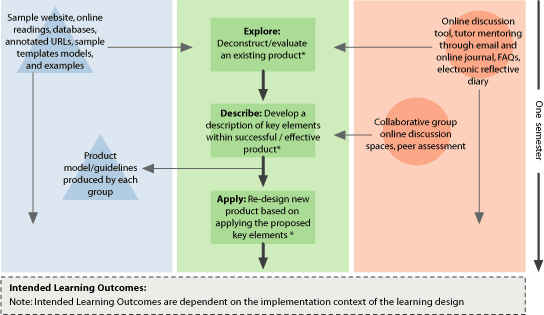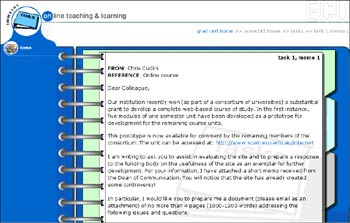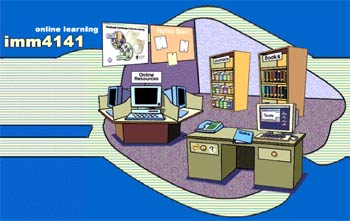|
 |
top

| |
The Learning Design Sequence is illustrated
as follows.


|
top

| |
EXPLORE,DESCRIBE AND APPLY PROBLEMS
- The learning is based on the solution of an open-ended
problem which has multiple possible solutions. The task
needs to be carefully selected so that it leads learners
to deal in thoughtful and reflective ways with the underpinning
conceptual basis and to acquire the knowledge and understanding
needed to act competently in the completion of the task.
- The learning setting is based on a problem-solving scenario
involving 3 tasks which follow in sequence.
HOW TO DESIGN THE PROBLEM?
- To create a setting where this precise form of problem-solving
can be applied, it is important to choose an authentic context
for the task and to create an overarching context where
the 3 tasks represent natural steps and a natural progression
of ideas and learning.
- The selection and specification of the problem needs to
be done in ways that facilitate and support the following
learning principles:
- Learner engagement by supporting learners’ intent
and expectations, catering for prior experiences and
motivation and the provision of socially engaging experiences.
- Challenges for learners that cause them to question
assumptions, to discern variations, to go beyond what
is provided and take ownership of the learning process.
- Acknowledgement of context through the provision of
appropriate problems and the situating of learning in
meaningful contexts.
- The involvement of practice that enables learners
to demonstrate what has been learned, to gain feedback
as they progress and reflect on the experience and develop
confidence.
- In creating the context for learning, it is important
for the following elements to be included:
- The problem upon which the learning is based must
provide students with the opportunity to deal meaningfully
with the underpinning knowledge.
- The activity must involve learners in planning, self-regulation,
metacognition, articulation and reflection.
- The learners should have to deal with a wide array
of information and need to pick salient information
from among distracting information.
- The task should not be completed alone but rather
attempted with the cooperation and assistance of others
who can provide feedback and guidance.
WHAT IS SIGNIFICANT ABOUT THE ACTIVITIES?
- The activities (sub-tasks) that students complete need
to be planned or selected by the students. This is a reflective
process and one which is an important part of the learning
process. The task solution must contain sufficient degrees
of freedom for students to take ownership of the problem
solving.
- The activities need to build the students’ knowledge
and understanding, and represent more than simply following
rules and procedures.
- The activities need to be guided by existing and actual
cases. The organising problem needs to be cast in a fashion
that provides students with the capacity to use existing
cases as part of the problem-solving process.

Fig 1. Example of a learning task involving
the exploration of a Website in unit IMM 4141
EXAMPLES OF TASKS
|
Journalism
- The course aims to help students learn how to write
articles for magazines.
- Students assume the role of a cadet journalist in
a Teen magazine, a magazine for teenage girls. In
the first task they are provided a recent edition
of the magazine and asked to critique the articles
in terms of their suitability and potential appeal
to readers of Teen magazine. The critique is in the
form of a review to the Editor.
- In the second task, they are required to develop
a series of guidelines and strategies which might
inform and scaffold writers of articles for this magazine.
- Finally, they are asked to work in groups to write
a story for the magazine based on a late and breaking
news event, e.g. the arrival of a rock band in town
ahead of a large concert. They are provided with all
the background information they need and use the guidelines
prepared in the second tasks as a scaffold to guide
this activity.
|
Business
- The course is learning how to develop marketing
plans. The students assume a role in a company looking
to float a dotcom initiative.
- For the first task, a proposal in the form of an
existing marketing plan is presented and students
are required to provide a report on it. The plan will
have some known weaknesses and the intention is for
students to discover and describe what these might
be. The outcome could be a report to a superior.
- In the second task, students are given a task to
develop some guidelines and strategies that will result
in a successful marketing plan in that organization
for the dotcom initiative. The development of the
guidelines needs to be given in some meaningful context.
- Finally the student is given the task of developing
a final marketing plan. The task is scaffolded by
the guidelines and strategies developed in task 2
and the student works with others to apply this information
in a creative and applied fashion. The setting provides
many supports in this final task including templates,
advice from senior staff, cases etc.
|
Security Studies
- The course is one in designing security systems
for shops and retail outlets. Students assume the
role of a security expert and are required to develop
a security design for a pharmacy. They are provided
with a series of three tasks.
- In the first instance they must explore a security
system for the pharmacy which is in place with the
view to assessing its security. (the system may have
recently been breached and they are looking to examine
how it may have been weak/deficient. The outcome from
this may be a report to a superior.
- The second task is the development of a series of
guidelines and strategies by which the quality security
systems for pharmacies can be designed and measures
of their potential strength/success. Again, this second
task needs to be cast in a realistic fashion.
- A third and final task may be the development of
a new security system for the pharmacy with given
constraints, e.g. budget.
|
|
top

| |
WHAT RESOURCES ARE NEEDED?
This form of learning setting needs to be resourced with
an array of items for students to choose from:
- examples of real life documents and materials relating
to the subject;
- policy documents;
- templates, instruction books, manuals, guides;
- access to people (opinions and advice) solving these problems
as part of their occupation;
- varying viewpoints on the subject/topic from different
stakeholders;
- theoretical treatises, e.g. journal papers, textbooks
on the subject.
WHAT IS IMPORTANT ABOUT THE RESOURCE CHOICE?
- The students need to choose those resources that they
deem necessary to learn the skills and understanding required
to successfully solve the problem. For this reason, this
learning design needs to have multiple resources many of
which supplement others and may even repeat information
in alternative forms.
- Students must have the means to source their own information
in addition to the resources provided.
- Students must be provided with more resources than they
need so they must choose those of greatest relevance.
- The resources must provide multiple perspectives supporting
different solutions to the problem.
- The resources should be primary sources wherever possible,
reflecting those that are used in real-life applications
of this knowledge.
- The resources should provide students with the means to
develop a strategy for problem solution based on information
at hand (students should not have to re-invent knowledge
etc).

Fig 2. The scope of the learning resources
for the unit IMM 4141
EXAMPLES OF LEARNING RESOURCES
|
Journalism
The online setting provides a range of resources to
support the student in the process of writing stories
for Teen magazine. Examples include:
- copies of other magazines for teen girls;
- demographic data describing the things young teens
are interested in, advertising policy for a Teen magazine,
etc;
- general documents describing how to write magazine
stories, headlines, information organization, sourcing
information, etc;
- company documents on storywriting. policies on ethics,
paying for information, privacy, previous stories;
and
- canned interviews with senior staff at the magazine,
other journalists.
|
Business
Possible resources include:
- documents describing how marketing plans are developed,
strategies for doing feasibility studies;
- examples of successful marketing plans, unsuccessful
marketing plans;
- information about the proposed dotcom venture e.g.
news stories, technology descriptions, projected sales,
etc;
- web links to similar institutions;
- newspaper articles and journal articles describing
dotcom ventures and their successes and failures.
|
Security
studies
Possible resources include:
- books describing security devices, how they work,
their functional details, costs etc;
- examples of security installations, guidelines for
designing installations;
- cases of security breaches, cases of attempted security
breaches;
- interviews with pharmacy staff about security problems;
- interview with pharmacy owner about expectations
budgets etc.;
- interviews with security experts.
|
|
top

| |
WHAT KIND OF SUPPORT IS NEEDED?
- Students need some form of guidance to assist in the development
of a plan of attack for the problem to be solved e.g. a
suggested approach, examples of ways to break the task down,
some indication of the expected form of the deliverables.
- Students need access to the opinions and feedback from
others e.g. students solving similar problems, peers to
collaborate with, mentors to seek advice from, experts to
provide expert opinion.
- Students need to be able to articulate thoughts and to
receive informed feedback and guidance.
WHAT ARE THE CRITICAL FORMS OF SUPPORT?
The critical forms of support include:
- the guides and strategies for the problem-solving process;
an example would be very helpful;
- support from peers and other problem-solvers;
- some capacity to seek information from experts who can
guide and provide advice;
- support from a tutor to guide the problem solving process.
WHAT IS THE SIGNIFICANCE OF THE SUPPORT STRATEGIES?
In this learning design students are providing solutions
to large, ill-defined and open-ended problems. The support
is necessary to ensure that:
- The problem-solving approach being taken will enable the
student to provide the deliverables required.
- The student understands the complexities in the situation
and has the knowledge and skills to deal with this.
- The solutions being proffered are sensible and meaningful
and are in accord with practices and processes in the area.
- The student is progressing in the right direction and
not stifled or stopped by impassable obstacles.

Fig 3. Learning supports for the unit IMM
4141 showing strategies, FAQs, institutional supports
EXAMPLES OF LEARNING SUPPORTS
| Journalism
- A Learning Guide, a suggested learning pathway detailing
possible approaches to completing the 3 tasks.
- Collaborative groups, students work with colleagues
and seek feedback and guidance in directed ways.
- Bulletin board where magazine drafts are posted
for feedback from sub-editors, content experts, company
legal eagles.
- FAQs, lists of questions and answers students have
made in previous offerings.
- Guest Editors, online access to experts who can
provide guidance for particular aspects of the three
tasks.
|
Business
- A Learning Guide, a suggested learning pathway detailing
possible approaches to completing the three tasks
associated with the marketing plan.
- Collaborative groups, students work with colleagues
and seek feedback and guidance in directed ways on
the various elements in the three given tasks.
- Bulletin board where marketing plans are posted
for feedback from company execs, legal reps etc.
- Workplace mentors who can read drafts and provide
feedback.
- FAQs, lists of questions and answers students have
made in previous offerings.
|
Security
studies
- A Learning Guide, a suggested learning pathway detailing
possible approaches to completing the three tasks.
- Collaborative groups, students work in teams to
complete the tasks with assigned roles.
- Templates and guides for plan drawings.
- External security people to provide informed feedback
on aspects of the design (e.g. tutor).
- Bulletin board where security designs are posted
for feedback from stakeholders e.g. customers, workers,
management.
- FAQs, lists of questions and answers students have
made in previous offerings.
|
|
top
|
 |
 |
 |
 |
 |
 |
 |
 |
 |
|



